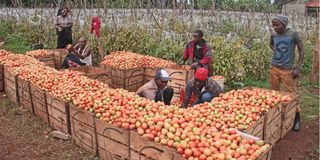Agronomist notebook: Three stages of harvesting tomatoes

Workers pack tomatoes in 60kg crates in Kirinyaga County for the market. Harvested tomatoes should be kept in a cool, shaded and well-ventilated area to minimise heat gain and reduce produce shelf-life.
What you need to know:
- Tomatoes should be harvested by gently twisting or rotating them to remove the stalk from the fruits.
- The farmer should harvest the fruits at the different ripening stages depending on the market requirements, mode of transportation and distance to the market.
- During transportation, the fruits acquire mechanical injuries rendering them unmarketable.
- Since some of the fruits are still developing, one should continue irrigating the crops as normal.
After weeks of waiting, Moses’ s tomatoes were fully mature and ready for harvesting this week.
Maturity of tomatoes depends on the variety and the environmental conditions. Most of the determinate varieties (bushy varieties mostly grown in open fields) take 75-80 days to mature after transplanting.
A farmer can also look for other maturity indexes such as the size of the fruits or the colour. Tomatoes should be harvested early morning, late in the evening, or during cool weather conditions.
This is because the fruit temperature is low, which reduces water loss and harvesting shock to the plant.
Tomatoes should be harvested by gently twisting or rotating them to remove the stalk from the fruits.
Ripening stage required
During the first harvest, care should be taken to avoid damaging the blooming flowers and small fruits on the plant.
Tomatoes can be harvested once or twice per week depending on the ripening stage required and the market demand. This can be done for two to three weeks before removing the crop – but this also depends on the variety.
The farmer should harvest the fruits at the different ripening stages depending on the market requirements, mode of transportation and distance to the market.
The maturity indices or the ripening stages are:
Mature-green: It happens where the fruit is green but internal gel is well-developed.
Breaker/turning: In this stage, up to 30 per cent of fruit surface has a definite colour break from green to yellow.
Mechanical injuries
Pink/light red: The fruits in this stage are usually 30-90 per cent pink/red colour.
Red/ripe: This is the last stage, where over 90 per cent of the fruit surface has changed to red colour.
In most cases, farmers should avoid harvesting tomatoes when the fruits are ripe or in the red stage as they easily go bad unless they are processing varieties.
Delayed harvesting also makes the fruits susceptible to pest and diseases such as Tuta absoluta and birds that feed on them.
During transportation, the fruits acquire mechanical injuries rendering them unmarketable.
While harvesting, Moses used crates to prevent the fruits from getting dirt. One should avoid harvesting the fruits and putting them in a sack as this causes them to get mechanical damage.
Some varieties are harvested with a stalk or the calyx to increase their shelf-life. For others, one should remove the calyx to improve the appearance.
Avoid spraying chemicals
Harvested fruits should be kept in a cool, shaded and well-ventilated area to minimise heat gain and reduce produce shelf-life.
After harvesting the tomatoes, Moses put them in crates and transported them using a wheelbarrow for grading, sorting and storage.
Before storage, clean dirty fruits using a clean cloth.
When the tomatoes are almost ready for harvesting, one should avoid spraying chemicals with a longer pre- harvest interval to control pests and diseases as they result in chemical residues on the fruits. Cultural and biological methods should be encouraged at this stage.
Since some of the fruits are still developing, one should continue irrigating the crops as normal. In our next article, we shall look at the tomatoes' post-harvesting techniques.





